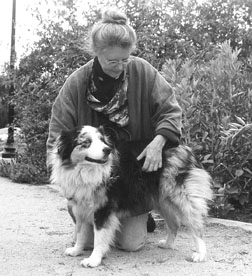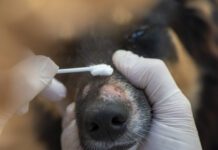This, the last installment in a three-part series, looks at some of the conventional and holistic therapies commonly prescribed in combating canine immune problems.
The first part of our series (“Looking for Immunity,” WDJ December 1999) described the body organs and molecular responses that actually constitute the immeasurably complex “system” of immunity that protects dogs from invasion by viruses, bacteria, fungi, and parasites. Many of the most common immune system disorders – including immune-deficient diseases, auto-immune disorders, and inappropriate immune responses – were described in the last installment of this series (“When They Are Not Immune,” WDJ January 2000).
Canine immune system disorders range from very common (such as seasonal allergies), to extremely rare disorders that afflict certain breeds (and even, in some cases, certain branches of individual breeds). Someday, the Canine Genome Project may well bring life-saving illumination to the process by which specific genes trigger specific diseases. At present, however, the inheritance of effective immunity continues to be a mysterious, if not star-crossed, commodity. Some dogs, like some people, are unlucky. However, the immunity that any individual dog is born with can often be improved with enlightened canine husbandry practices, traditional medical care, and complementary care from holistic health modalities. Bad immune luck can be turned into improved health for many dogs.

As always, however, any immune-enhancing tactics should begin with a thorough veterinary medical examination and consultation. What therapies work for one dog might not work for another, and, at worst, could trigger immediate life-threatening reactions. Manipulating the immune system is an uncertain science and art. The more a veterinarian knows about your dog’s medical history, genetic inheritance, and lifestyle, the better his or her chance for a favorable outcome.
The goal: Self-healing
We’ve learned a lot about the immune system in the past 20 years, most significantly, that the body is full of cells and chemicals that, when the entire system is working as it should, perform miracles of regulation. And, as is so often the case in medical research, our earliest successes have stemmed from our attempts to mimic some of those miracles. These efforts have led to the development and widespread use of a number of drugs that can suppress immune responses, which is helpful (and even life-saving) in cases of autoimmune disease or hyperactive immune responses such as allergies. More recently, we have begun to develop drugs that can stimulate increased immune responses in the case of immune-deficient conditions.

These efforts are laudable – even miraculous in themselves. But it’s well understood that our artificial methods of influencing the complex, mysterious immune system are inferior and clumsy compared to effects of what the body can do when it’s working as it should. All medications produce side effects in the body, and often, the more powerfully they perform the job they were developed to perform, the more adverse these unwanted effects are. Usually, though, we’ll go ahead and take those side effects in favor of no improvement at all!
Grossly simplified, the goal in holistic medicine is to somehow cajole or inspire the body to heal itself. Increasingly, this is the focus of new developments in Western medicine, too. Yesterday’s leading edge technology was focused on creating drugs that “fight” viruses and bacteria; today’s revolution is in developing drugs that stimulate the body to create and/or release its own chemical “medications” that fight invaders.
But as Western medicine focuses on the search for wondrously effective (and profitable) drugs, Eastern and holistic medicine takes a less-sexy approach: trying to “fine-tune” the body by any means possible to empower its all-powerful immune system. This may entail employing all sorts of worthy, if wacky, methods of positive influence. Chiropractic is often used to optimize the function of the nervous system. Nutrient levels are manipulated in numerous ways in an effort to create the most comfortable chemical medium for the cellular agents of immunity. Massage, TTouch, and acupressure are used to enhance circulation of immune cells and to encourage their continued and appropriate production. Bach Flower essences, colors, or fragrant essential oil are used to reduce stress and all of its deleterious chemical cohorts from the body.
The list is endless, but the goal is always the same: to get the body to fight “non-self” cells, and heal its own.
Putting principles into practice
Our premise is that improving immune health is probably the single most important thing you can do for your dog. Here’s a common condition that illustrates this point:
Flea Allergy Dermatitis (FAD) is a perfect example of how a malfunctioning immune system reduces a dog’s ability to cope with what should be a minor annoyance. Few dog owners regard this syndrome as an “immune problem,” and yet, by improving the responses of the affected dogs’ immune systems, one can stop this disorder in its tracks. Here’s how:
First, it has been widely observed that healthy dogs have far fewer problems with fleas than unhealthy dogs. One generally thinks of this the other way around – that it’s the fleas that make the dog unhealthy – but there is much evidence to suggest the opposite. In fact, a persistent flea infestation is often an indicator that a dog is suffering from additional, underlying health problems. Healthy dogs seem to have innate immune defenses that keep flea populations in check, but flea populations thrive and multiply on unhealthy dogs. Once a dog develops an allergic sensitivity, it can never be completely overcome, and with reactive rather than proactive treatments, sensitivity tends to increase.
Conventional treatment generally revolves around administration of corticosteroids, which are used for their anti-inflammatory effects; they very effectively “stop the itch.” Unfortunately, these drugs are also immunosuppressive. They compromise the dog’s ability to defend against viral, bacterial, parasitic and other invaders, and depress the body’s resistance to infection. In contrast, holistic veterinarians stress a balanced, long-term strategy. This might not get the dog to stop scratching or chewing himself overnight, but it can encourage the dog’s body to respond to the allergens present in the flea saliva in a less overactive fashion, while increasing the dog’s natural defenses to the fleas.
Needless to say, both conventional and holistic treatments for FAD include strategies for keeping fleas away from both the flea-allergic dog and its environment. How the dog’s owner undertakes this task can have serious repercussions on the dog’s health. There are many commercial flea products which either kill adult fleas outright, or chemically interrupt some stage of their life cycle, preventing young fleas from developing into adults capable of reproduction, for example.
While these products usually work as intended – eliminating a dog’s current flea population – they can trigger unpredictable and serious side effects in sensitive or vulnerable dogs. It’s a conundrum: the dog has immune problems, which leaves it susceptible to reactions from fleas and flea-borne illness, but the most effective flea killers may aggravate immune problems. So the task at hand is twofold: You try to conduct a gentle war on the fleas, discouraging their populations from settling into your home (as discussed in “Flee, Evil Fleas,” June 1998) without causing any disruption or destruction of your dog’s health. (As an example, you may use oils and extracts of lavender, eucalyptus, tea tree, or cedar around the home, to repel fleas without burdening your dog’s health in any way.)
Simultaneously, you work to building the dog’s basic constitutional health, which will, in turn, enable him to mobilize his own defenses against them. Holistic veterinarians usually begin and end all therapies with improved basic nutrition. Natural immune-enhancers could be prescribed: vitamins A, E, and C; fish and primrose oil, echinacea, and others. Massage or other physical therapies promote beneficial circulation.
In addition, you check to make sure that you aren’t mounting any obstacles to the dog’s self-healing: exposure to toxins (including poor quality foods), or too much stress. Any and all health problems the dog may display – such as itchy, irritated skin – are treated with substances that interfere as little as possible with his immune responses; in other words, using little or no cortisone creams or sprays, or immune-suppressing oral or injectable steroids. Instead, irritated skin might be soothed with calendula ointment or an oatmeal bath.
In theory, and thankfully, our readers can testify that in fact, too, as general health improves, signs of FAD naturally subside.
Stopping attacks on “self”
In autoimmune diseases, where a dog’s immune defenses inappropriately attack the body itself, mistaking “self” for “non-self” invaders, the desired strategy is to alter the self-destructive cellular pattern. A good example is Autoimmune Hemolytic Anemia (AIHA). In simple terms, AIHA causes the body to mount a “defense” against its own red blood cells, destroying the cells that carry the oxygen vital to life. Conventional medicine employs immunosuppressive corticosteroids and other more powerful drugs to disrupt the attacks, in hopes of sparing enough red blood cells to induce a remission. Unfortunately, all of the immune system is suppressed, not just the misfiring antibodies, leaving a dog vulnerable to other opportunistic infections. In life-threatening situations, blood transfusions are sometimes recommended, or even a new artificial blood product called Oxyglobin, which delivers oxygen to the cells faster than real blood and does not require blood typing.
In any non-emergency context, holistic veterinarians would probably begin with nutritional therapies which promote the growth of red blood cells: fresh meat, liver extracts and other B-vitamin sources; Vitamins C and E; and iron-rich herbs such as burdock, nettle or red clover.
While the prevalent forms of AIHA (accounting for 80 to 90 percent of all cases) are less severe and can often be treated as a chronic, controlled illness (as most immune disorders are), in the peracute form, time is of the essence, leading most people to seek conventional treatment first, and alternative therapies as a last resort. But in fact, alternative veterinarians cite successful therapies where, for example, B vitamin injections in certain acupuncture points induced immediate red blood cell production in a dog’s bone marrow, buying time for other immune-enhancing therapies to take hold.
Conclusion
When your dog has a life-threatening immune illness, there may not be a veterinarian on earth who can work miracles for that particular dog; immune problems tend to pick up momentum over time, compromising more and more systems. And many immune diseases are linked to factors beyond a dog owner’s control, in any reasonable sense of the word. But by optimizing those immune variables that they can control – foods, and exposure to drugs, vaccines, toxins, and stress – dog owners can level the immune playing field with the best home care, and the best professional advice they can find.
-By Roger Govier
Roger Govier is a freelance writer from San Francisco. Govier has prepared articles on many of WDJ’s toughest topics, from cancer to vaccinations.






